12 Best Student Productivity Apps for 2025
Discover the 12 best student productivity apps for 2025. Boost focus, organize notes, and ace your classes with our in-depth guide to essential tools.
The modern student's life is a high-stakes balancing act of lectures, assignments, research, and personal time. Juggling these demands requires more than just willpower; it demands the right digital toolkit. The best student productivity apps can transform chaotic study sessions into streamlined, efficient workflows, helping you learn smarter, not just harder. But with countless options flooding the app stores, how do you build the perfect digital arsenal to conquer your coursework?
This guide cuts through the noise. We have compiled the definitive list of the 12 best student productivity apps for the academic year, moving beyond generic feature lists to provide in-depth analysis. We will explore everything from all-in-one platforms like Notion to specialized tools for focused work (Forest) and reference management (Zotero). For each app, you will find a detailed breakdown of its key features, pricing, platform compatibility, and a frank assessment of its pros and cons. We also provide practical, real-world use cases to show you exactly how to integrate these tools into your daily study routine for maximum impact.
Our goal is to help you find the perfect combination of tools for your specific needs. Many modern solutions integrate artificial intelligence to automate tasks and provide smarter insights. As you explore the digital tools available, consider the cutting-edge capabilities of the 7 Best AI productivity tools that can significantly enhance your academic journey. This guide will also demonstrate how a centralizing platform like zemith.com can unify your various apps, turning digital clutter into academic clarity. Each entry includes direct links and screenshots to help you make informed decisions quickly. Get ready to revolutionize the way you study.
1. Zemith
Zemith stands out as our top choice, establishing a new benchmark for what student productivity apps can achieve. It's not just a single tool; it's a comprehensive AI-powered ecosystem designed to streamline every facet of academic life, from initial research and writing to complex coding projects and creative endeavors. What sets Zemith apart is its consolidation of leading AI models like Gemini-2.5 Pro and Claude 4 Sonnet into one unified, subscription-free workspace, eliminating the need to juggle multiple platforms and saving students significant time and money.
This platform moves beyond simple task management to become an active partner in the learning process. Its intelligent features are engineered to handle the heavy lifting of academic workflows, allowing students to focus on critical thinking and comprehension rather than tedious administrative tasks.
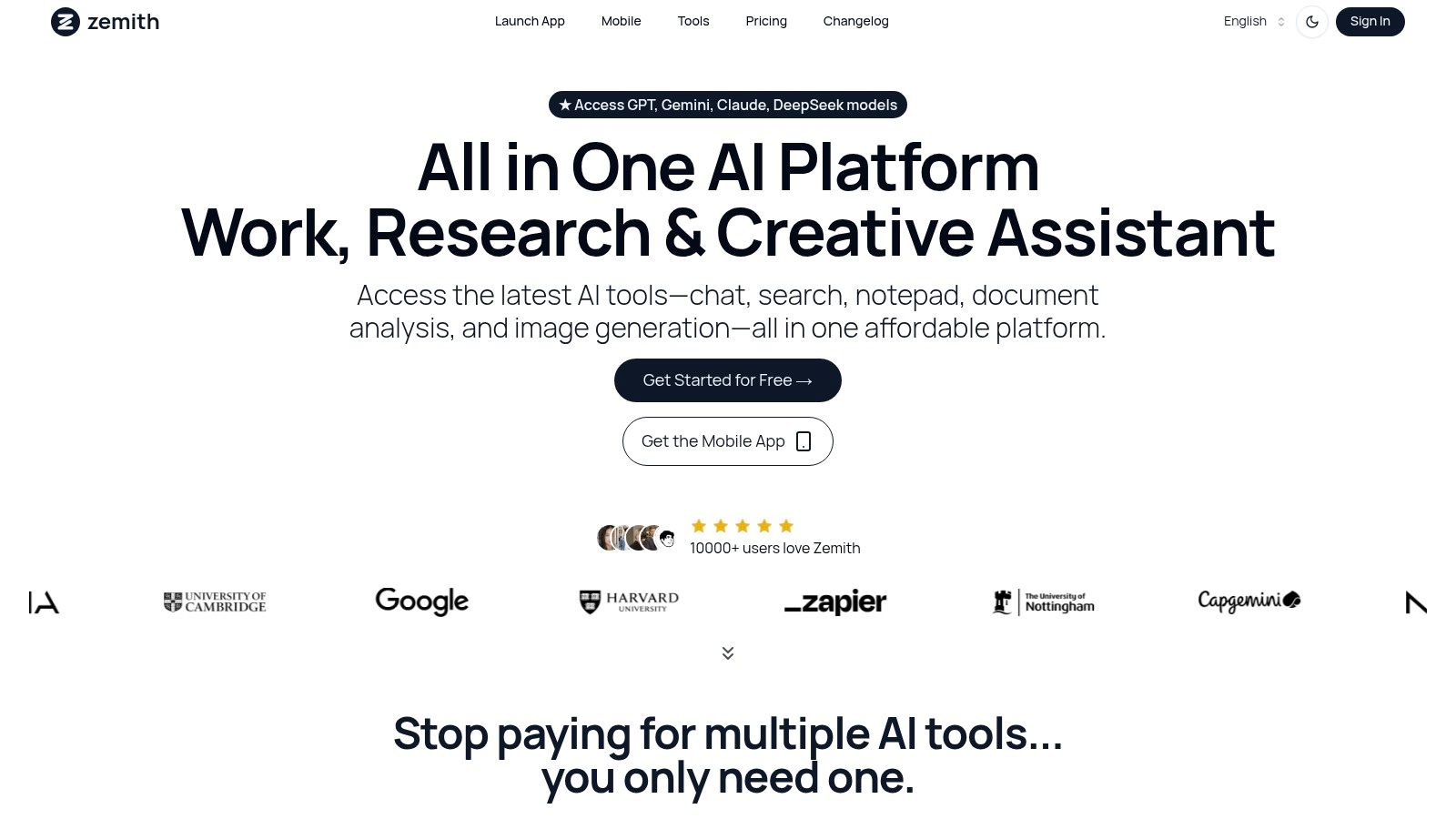
Key Features for Unmatched Student Productivity
Zemith's feature set is meticulously tailored to address the core challenges students face daily. The Intelligent Document Assistant is a game-changer for study sessions; simply upload a PDF of a textbook chapter or research paper, and Zemith can generate instant summaries, create interactive quizzes, or even convert the text into a podcast for on-the-go learning.
The AI-powered Smart Notepad fundamentally enhances the writing process. It provides real-time autocomplete suggestions, helps rephrase complex sentences for clarity, and can generate entire paragraphs based on your prompts. This tool is invaluable for drafting essays, lab reports, and even creative writing assignments with greater speed and precision.
For students in creative or technical fields, Zemith offers robust support. The platform includes powerful image generation and editing tools, perfect for creating visuals for presentations or projects. Meanwhile, computer science students can leverage the AI-assisted coding features for writing, debugging, and live-previewing code, significantly accelerating development cycles.
Practical Implementation and User Experience
Getting started with Zemith is straightforward, with a generous free plan that offers access to many core features. The interface is clean and intuitive, designed to minimize the learning curve often associated with powerful software. Students can immediately organize their work into project libraries, ensuring all notes, documents, and generated content for a specific class are kept in one place.
A practical tip for new users is to leverage the prompt galleries to understand how to get the most out of the AI. These pre-built prompts can help you quickly master tasks like conducting competitor analysis for a business class or fact-checking sources for a history paper.
Zemith's true strength lies in its ability to unify disparate academic tasks. It's the only platform a student might need to go from a blank page to a fully researched, well-written, and visually supported final project.
Platform and Pricing Overview
| Feature | Details |
|---|---|
| Ideal For | All students, especially those in research-heavy, writing-intensive, or technical fields. |
| Platform | Web, Mobile App |
| Pricing | Free plan available. Paid plans start at $6.99/month (billed annually). |
| Website | https://www.zemith.com |
Pros:
- Integrates multiple top-tier AI models, offering unparalleled versatility.
- Comprehensive toolset covers research, writing, coding, and creative work.
- The document assistant's quiz and podcast features offer unique study methods.
- A generous free tier makes it one of the most accessible student productivity apps.
Cons:
- The sheer number of features may feel overwhelming for users new to AI tools.
- Heavy users may need to upgrade to a paid plan for higher usage limits.
2. Apple App Store
For students invested in the Apple ecosystem, the App Store is the primary gateway for discovering and managing essential software. More than just a marketplace, it’s a highly curated environment where the quality and security of student productivity apps are rigorously vetted. This curation is its key differentiator, saving you the time and risk associated with sifting through countless low-quality clones to find a genuinely useful tool.
The user experience is seamless, with secure payments tied to your Apple ID and centralized updates for all your applications. Deep integration with hardware, like Apple Pencil support on iPad or interactive widgets on the home screen, elevates how you interact with study tools, turning your device into a more cohesive productivity system.
Key Considerations
- Platform: iOS, iPadOS, macOS
- Pricing: Varies per app (free, one-time purchase, subscription)
- Standout Feature: Strong editorial curation and 'Today' tab stories often highlight innovative student apps.
- Limitation: App purchases are locked to the Apple ecosystem; you often need to repurchase software on Windows or Android.
Pro Tip: Look for apps that offer cloud sync or web versions to avoid being completely locked into one ecosystem. For example, using an integrated platform like Zemith ensures that your core work remains accessible from any device—whether it's an iPhone, a Windows laptop, or an Android tablet—providing ultimate flexibility.
This curated approach makes the App Store an indispensable resource, ensuring the tools you download are both safe and optimized for your devices. It's the most reliable starting point for finding high-quality study aids specifically designed for iPhone, iPad, and Mac. While the platform-specific nature is a drawback, the quality control and seamless integration provide a superior and secure experience.
Visit the Apple App Store
3. Google Play Store
As the official marketplace for Android and many ChromeOS devices, the Google Play Store is the go-to hub for an enormous catalog of student productivity apps. Its sheer volume is its defining feature, offering everything from advanced note-takers and focus timers to comprehensive office suites. This vast selection ensures that no matter your budget or study needs, there is likely a free or paid application available to help you succeed.
The platform’s strength lies in its openness and integration with the Google ecosystem, including Google Workspace for Education, which allows schools to manage app distribution. User-driven ratings and reviews are crucial for navigating the massive library, helping you identify high-quality tools and avoid poor-performing ones. This open model fosters competition and innovation, leading to a wider variety of specialized apps compared to more closed ecosystems.
Key Considerations
- Platform: Android, ChromeOS
- Pricing: Varies per app (free, one-time purchase, subscription)
- Standout Feature: Massive app selection with options at every price point, including many powerful free tools.
- Limitation: App quality can be inconsistent; users must rely heavily on reviews and "Editor's Choice" picks to find reliable software.
Pro Tip: Use the "Google Play Pass" subscription for access to hundreds of premium apps and games without ads or in-app purchases. This is a cost-effective way to try various tools, but for a truly integrated workflow, consider how these apps connect. A central hub like Zemith can unify your workflow, allowing you to use specialized apps from the Play Store while consolidating your core research and writing in one place.
While the quality control isn't as strict as curated alternatives, the Google Play Store's unparalleled selection and cross-device compatibility for Android phones, tablets, and Chromebooks make it an essential resource. It provides the flexibility and choice necessary to build a personalized and effective digital toolkit for your academic journey.
4. Microsoft Store
For students operating primarily on Windows devices, the Microsoft Store serves as the central hub for discovering and managing essential software. Much more than a simple download portal, it is a secure, curated marketplace that simplifies finding and installing powerful student productivity apps. Its main advantage lies in its seamless integration with the Windows operating system, offering one-click installations and centralized, automatic updates that eliminate manual maintenance.
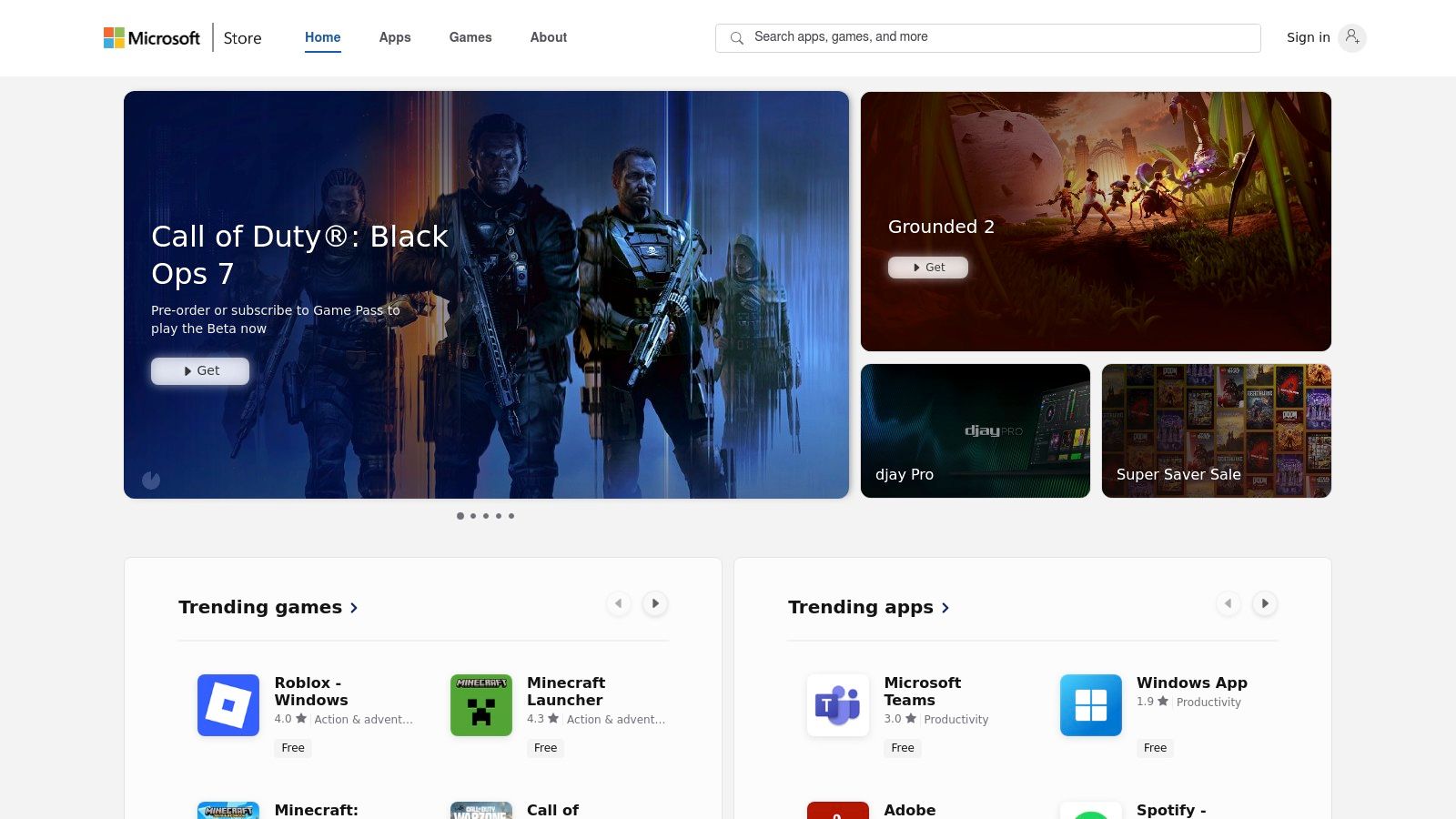
The user experience is streamlined, with curated collections and charts like "Top Free Apps" making it easy to spot popular tools. Deep connections with the Microsoft 365 ecosystem mean that apps like OneNote and Microsoft To Do work flawlessly alongside third-party downloads. This creates a cohesive digital environment where your task manager, note-taker, and calendar are all synchronized and optimized for your PC.
Key Considerations
- Platform: Windows 10, Windows 11
- Pricing: Varies per app (free, one-time purchase, subscription)
- Standout Feature: Integration with Microsoft 365 and the annual Store App Awards which highlight high-quality, innovative applications.
- Limitation: The app catalog is not as extensive as its mobile counterparts, and some applications are simply web-wrappers with limited offline functionality.
Pro Tip: U.S. college students can often get a free one-year subscription to Microsoft 365 Personal. This is a great starting point, but to elevate your productivity, integrate these tools with an AI-powered workspace. For instance, you can draft an essay in Word and then upload it to Zemith to generate summaries, check for clarity, or create study questions, combining the best of both platforms.
By offering a secure and integrated software environment, the Microsoft Store is an indispensable resource for any Windows-based student. It ensures the apps you rely on are verified, up-to-date, and optimized for your device. While the selection can be narrower than other platforms, the direct OS integration and focus on quality make it a reliable first stop for outfitting your PC for academic success.
5. Notion
Notion is a powerful all-in-one workspace that consolidates notes, tasks, databases, and wikis into a single, highly adaptable environment. For students overwhelmed by juggling multiple apps, it offers a unified solution to organize everything from class schedules and reading notes to collaborative group projects. Its key strength is its modularity; you can build custom systems that precisely match your study habits, making it one of the most versatile student productivity apps available.
The user experience is centered around pages and databases, which can be linked and customized with different views like calendars, Kanban boards, and timelines. This flexibility allows students to create interconnected knowledge bases, track assignments with detailed properties, and even implement advanced study techniques like spaced repetition using community-built templates. Deep cross-platform syncing ensures your workspace is always accessible.
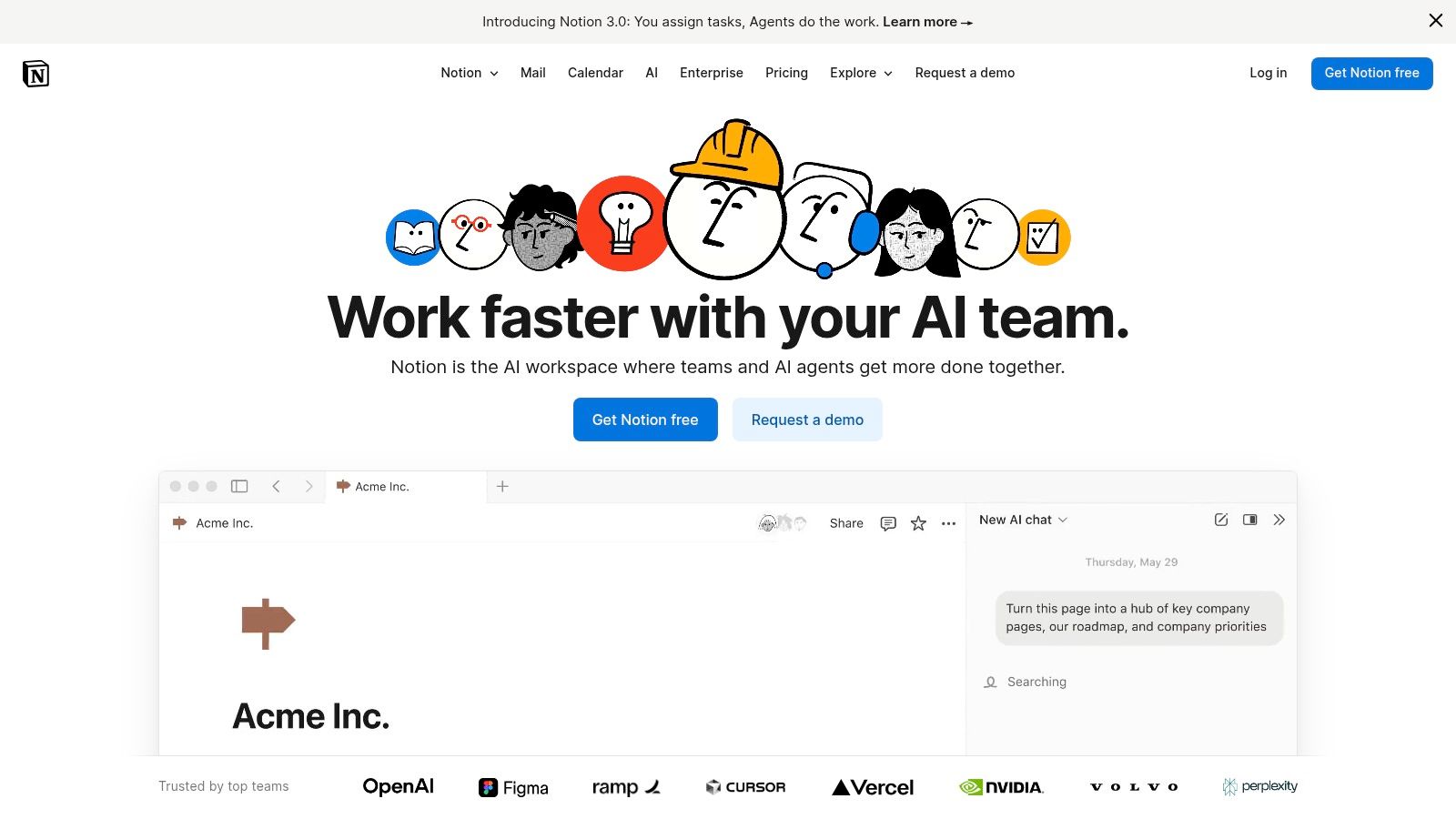
Key Considerations
- Platform: Web, macOS, Windows, iOS, Android
- Pricing: Free Personal plan; Plus plan is free for eligible students and educators.
- Standout Feature: Extreme customizability with interconnected databases and a vast library of student-made templates.
- Limitation: The steep learning curve can be intimidating for new users, and its AI features often require a paid add-on, unlike platforms like Zemith where advanced AI is integrated into the core experience.
Pro Tip: Don't start from scratch. Explore Notion's official student template gallery or communities on Reddit to find pre-built dashboards for class notes and assignment tracking. Once you have your structure, you can supercharge your content creation by drafting text in a more powerful AI writer like Zemith and pasting it into your Notion pages to keep everything organized.
Notion’s "everything in one place" philosophy makes it an indispensable tool for students seeking a centralized hub for their academic life. While it requires an initial time investment to learn, the payoff is a deeply personalized and efficient productivity system. For those who want their tools to adapt to them, not the other way around, Notion is a top-tier choice.
6. Todoist
Todoist is a masterclass in task management, offering a clean, intuitive, and powerful platform for students to organize everything from daily homework to complex final projects. Its core strength lies in its simplicity and ubiquity, available on virtually every device. This allows you to capture tasks the moment you think of them, whether you’re on your laptop, phone, or even a smartwatch, ensuring no deadline or idea slips through the cracks.
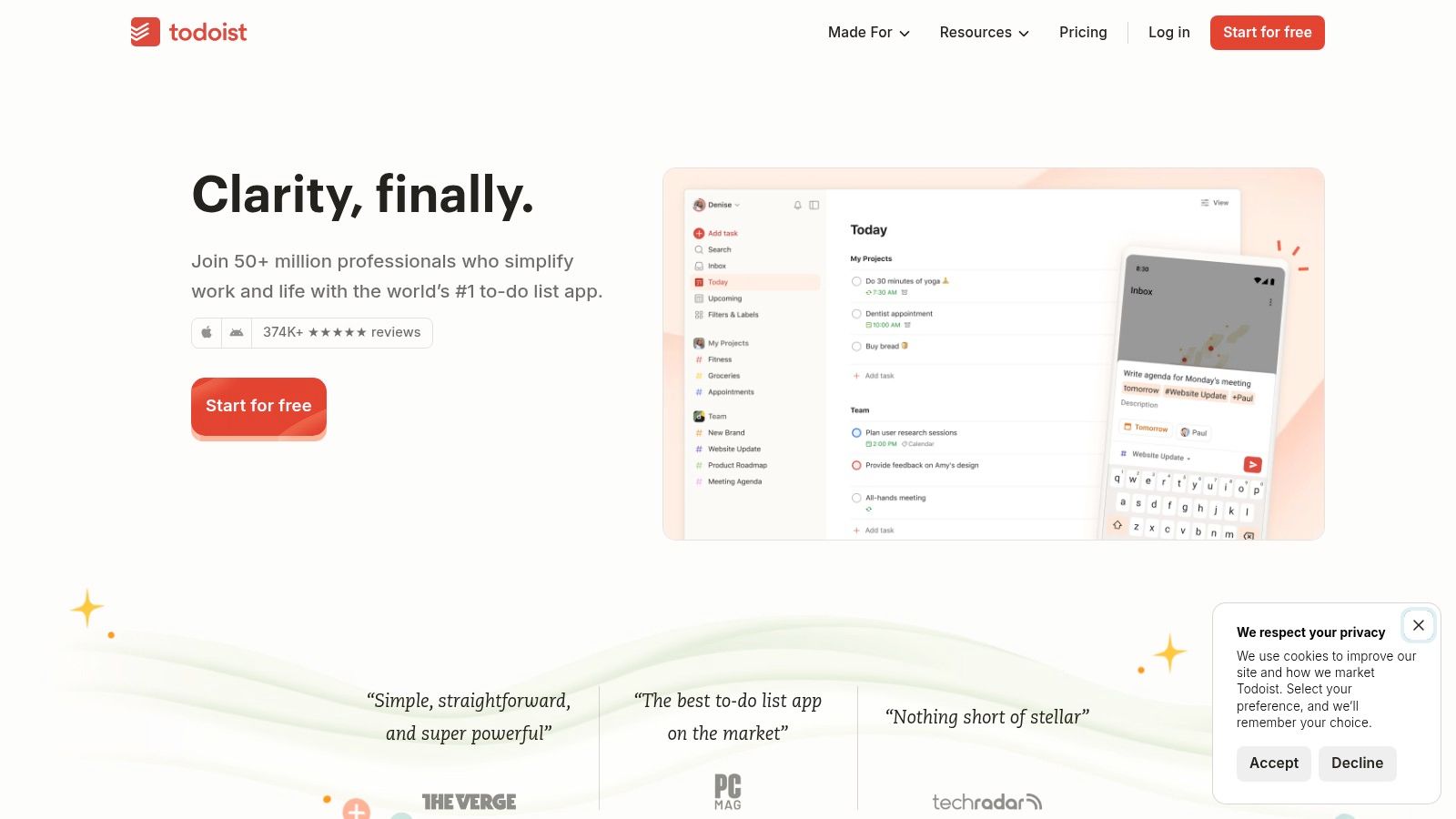
The platform’s natural language input is a significant time-saver; you can simply type "Submit history essay tomorrow at 4 pm p1" and Todoist will automatically schedule the task with the correct due date and priority level. This friction-free experience makes it one of the most efficient student productivity apps for keeping track of a busy academic schedule. Its reliable syncing and collaboration features also make it ideal for group projects, allowing you to assign tasks and monitor progress seamlessly.
Key Considerations
- Platform: Web, Windows, macOS, iOS, Android, Linux, browser extensions
- Pricing: Free (limited projects); Pro plan from ~$4/month
- Standout Feature: Natural language processing for quick and intuitive task entry.
- Limitation: Key features like reminders and unlimited projects are locked behind the Pro subscription.
Pro Tip: Combine Todoist with a dedicated note-taking platform. While Todoist excels at managing what you need to do, integrating it with a tool like Zemith for your research notes and project outlines creates a comprehensive productivity system. Use Todoist for actionable deadlines and link directly to your detailed knowledge base in Zemith to keep everything connected.
Todoist strikes an exceptional balance between simplicity for beginners and depth for power users. While the free version is functional, the Pro plan unlocks its full potential, making it a worthwhile investment for students juggling heavy course loads. Its cross-platform consistency and focus on quick task capture make it an indispensable tool for academic organization.
7. Goodnotes
For students who prefer the flexibility of handwritten notes in a digital format, Goodnotes has become the gold standard. It transforms tablets, particularly the iPad with an Apple Pencil, into powerful digital notebooks perfect for lectures, research, and creative brainstorming. More than just a simple note-taker, it excels at PDF annotation, allowing you to mark up lecture slides, textbooks, and research papers directly. Its ability to search your own handwriting turns scattered notes into a powerful, indexed knowledge base.
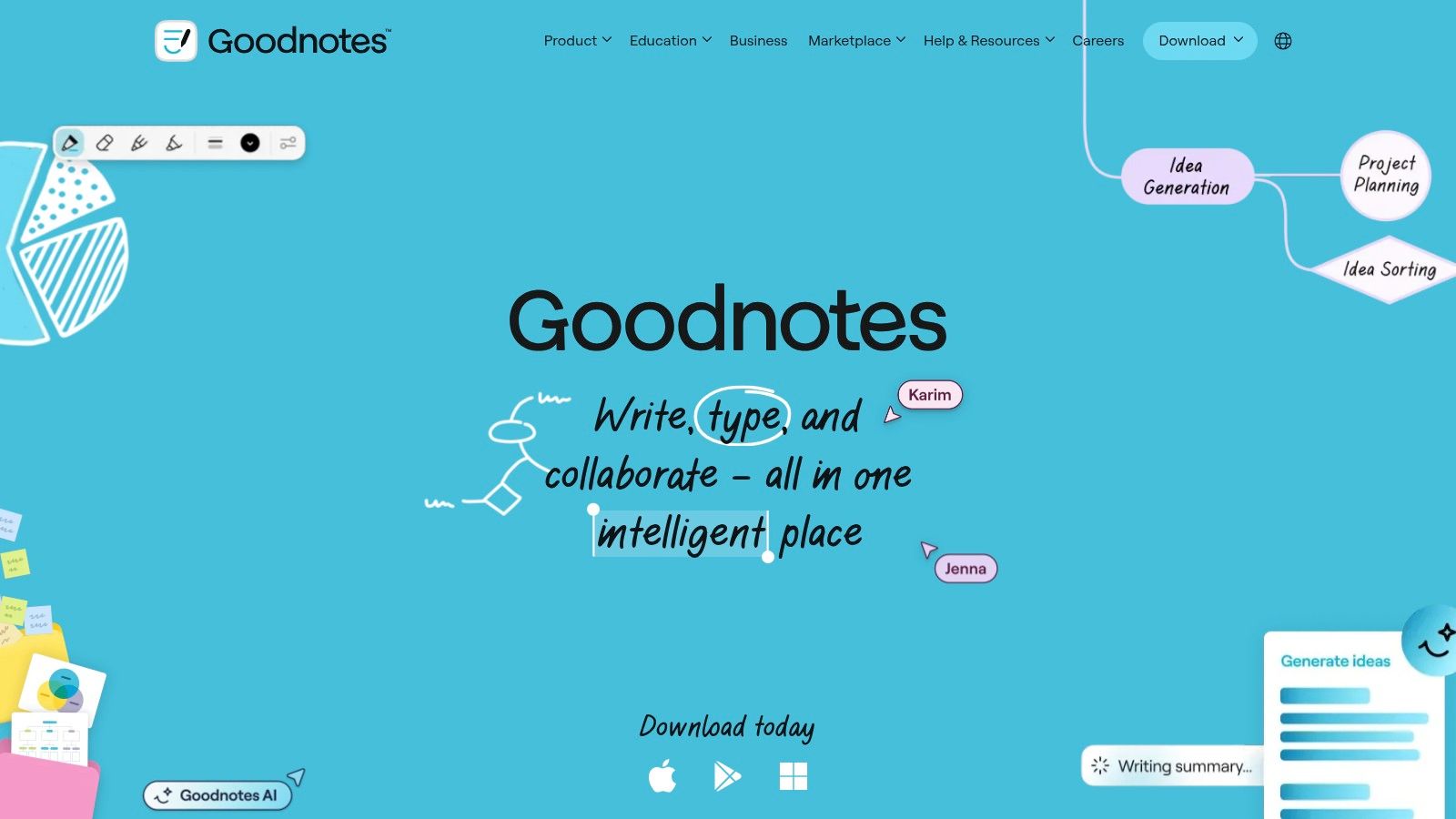
The user experience is intuitive, closely mimicking the feel of pen on paper while offering digital advantages like resizable diagrams, color-coded notes, and a vast marketplace for templates. New AI-powered features, such as automatic spellcheck for handwriting and AI-generated study sets, further elevate it as a top-tier student productivity app. For a deeper dive into its capabilities, see our analysis in Zemith’s guide to the best note-taking apps.
Key Considerations
- Platform: iPadOS, iOS, macOS, Windows, Android
- Pricing: Free version with limitations; premium features via subscription or a one-time purchase (Goodnotes 6).
- Standout Feature: Best-in-class handwriting recognition and search, making handwritten notes as useful as typed text.
- Limitation: The best experience is heavily tied to a stylus-enabled tablet; functionality on non-touch devices is more limited.
Pro Tip: After a lecture, export your handwritten notes as a PDF and upload them to Zemith’s Document Assistant. This allows you to instantly convert your notes into flashcards, generate practice quizzes, or ask clarifying questions, bridging the gap between handwriting and AI-powered study tools.
Goodnotes bridges the gap between traditional note-taking and digital efficiency, making it an indispensable tool for students in STEM, humanities, and beyond. While its full potential is unlocked with specific hardware, its core functionality and cross-platform sync make it a superior choice for organizing academic life.
8. Forest
For students battling digital distractions, Forest offers an ingenious and visually rewarding solution to stay focused. This app gamifies the Pomodoro Technique by having you plant a virtual tree that grows during your study session. If you leave the app to browse social media or other blacklisted sites, your tree withers and dies, providing a powerful psychological incentive to remain on task. It transforms the abstract goal of "focusing" into a tangible, satisfying achievement.
This simple yet effective behavior-modification design is what makes Forest one of the most beloved student productivity apps. The sense of accomplishment from growing a flourishing virtual forest, complete with statistics and shareable achievements, keeps users engaged long-term. Furthermore, the app partners with a real-tree-planting organization, Trees for the Future, allowing you to spend virtual coins earned in-app to fund the planting of actual trees.
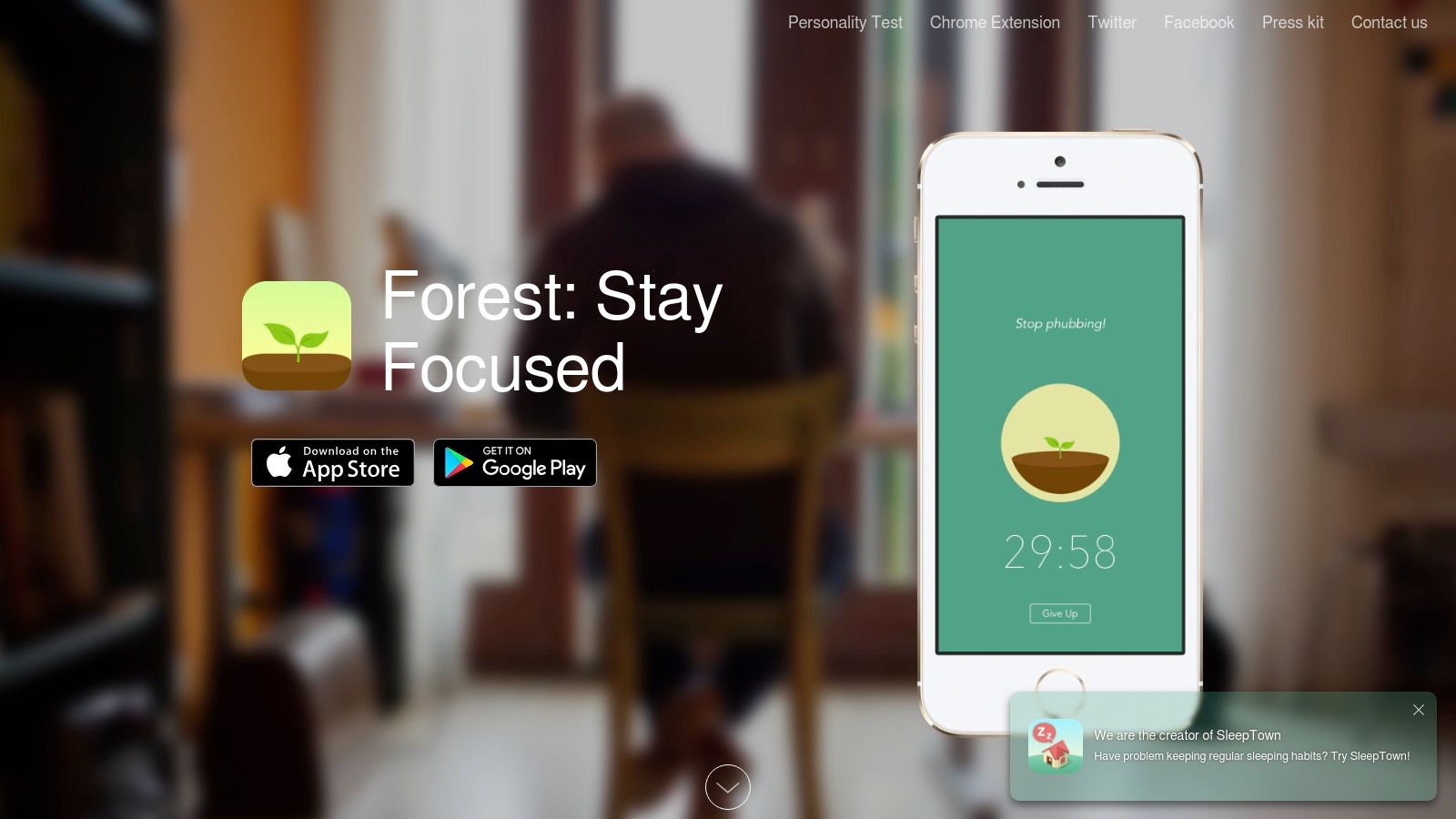
Key Considerations
- Platform: iOS, Android, Chrome Extension
- Pricing: One-time purchase on mobile (varies by platform); free with ads on Chrome.
- Standout Feature: Gamified focus timer that links virtual progress to planting real trees, creating a strong motivational loop.
- Limitation: It is purely a focus timer and not a comprehensive task manager; separate purchases are required for iOS and Android versions.
Pro Tip: Use the "Allow List" feature to permit access to essential study apps. For an effective deep work session, allowlist your primary research and writing hub, like Zemith, so you can access your notes and AI assistant without breaking your focus timer and killing your virtual tree. This ensures you stay productive, not just offline.
Forest excels at its core mission: keeping you off your phone during deep work sessions. While it doesn't organize your tasks, it provides the focused environment needed to complete them. Its charming interface and real-world impact make it a uniquely motivating tool for any student aiming to build better study habits and conquer procrastination.
9. MyStudyLife
Unlike generic calendars or task managers, MyStudyLife is engineered from the ground up specifically for the academic world. It understands that a student's schedule isn't a simple 9-to-5, accommodating complex rotating and block timetables that standard planners fail to handle. By integrating class schedules, assignments, and exam dates into one unified dashboard, it becomes a single source of truth for your entire academic life, making it one of the most focused student productivity apps available.
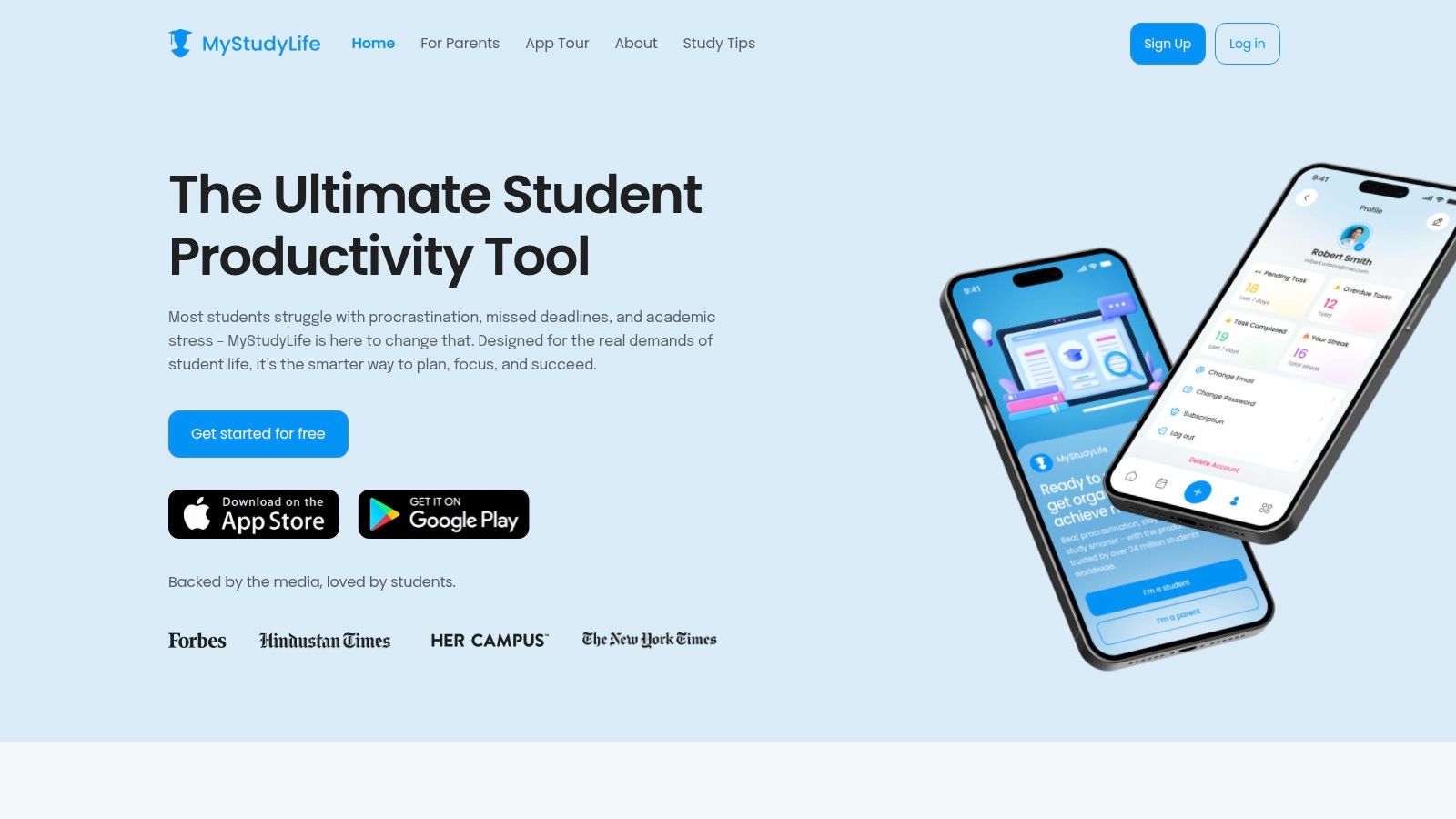
The platform's strength lies in its specialized design. Instead of forcing you to adapt a business-oriented tool for academic use, it provides a purpose-built framework that tracks everything from homework deadlines to grade performance. Its cross-platform synchronization ensures your schedule is always current, whether you're checking it on your phone between classes or planning your week on a laptop.
Key Considerations
- Platform: Web, iOS, Android
- Pricing: Free basic version; MyStudyLife+ subscription for advanced features.
- Standout Feature: Advanced support for complex academic schedules (A/B weeks, block rotations) that most standard calendars lack.
- Limitation: The ecosystem is relatively closed, with fewer third-party integrations. This means you can't easily connect it to a broader knowledge base or AI workspace like Zemith.
Pro Tip: Use MyStudyLife as your high-level strategic planner to know what is due and when. Then, execute the actual work—research, writing, and studying—in a more comprehensive platform. This creates a clear separation between scheduling and deep work, helping you focus on the task at hand.
MyStudyLife excels by focusing on a single, well-defined problem: academic organization. Its student-centric features eliminate the need for cumbersome workarounds, providing a streamlined and intuitive way to manage the unique demands of school. For students who find general-purpose planners lacking, it’s an essential tool for staying on top of a hectic academic calendar.
10. Grammarly
For students tasked with writing anything from a lab report to a final thesis, Grammarly acts as an essential digital proofreader and writing coach. It moves beyond basic spell-check by providing real-time feedback on grammar, punctuation, clarity, and tone. This immediate analysis is its key differentiator, helping you refine your academic writing on the fly and avoid common errors before submission. It is one of the most crucial student productivity apps for improving written communication.
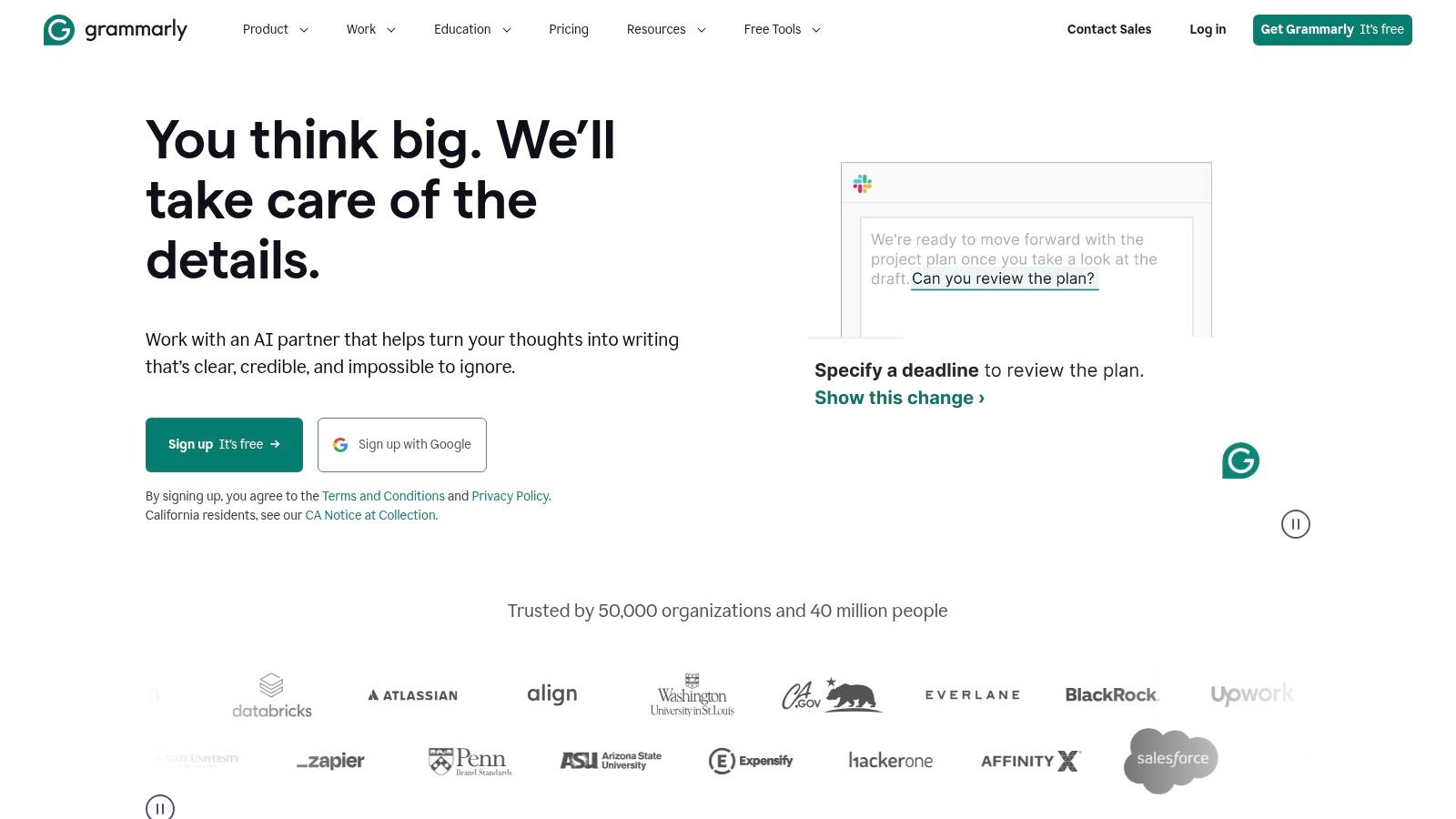
The platform integrates seamlessly into your existing workflow, with extensions for browsers like Chrome, plugins for Microsoft Word and Google Docs, and dedicated desktop and mobile apps. This ensures that whether you're drafting an email to a professor or finalizing a term paper, your writing is consistently clear and professional. The user experience is intuitive, with suggestions appearing as simple underlines that you can accept or dismiss with a click.
Key Considerations
- Platform: Web, Windows, macOS, iOS, Android, Browser Extensions (Chrome, Safari, Firefox, Edge), Microsoft Office Add-in
- Pricing: Free basic plan; Premium plans with advanced features start around $12/month (billed annually)
- Standout Feature: Real-time tone detector helps you ensure your writing sounds confident, formal, or analytical as needed.
- Limitation: While excellent for proofreading, it lacks the content generation and idea development capabilities of integrated AI writing assistants found in platforms like Zemith.
Pro Tip: Use a comprehensive AI writing tool like Zemith for the initial drafting, outlining, and idea generation phases of your essay. Then, use Grammarly for the final polishing and proofreading stage. This two-step process leverages the strengths of both tools: generative AI for speed and creativity, and Grammarly for precision and correctness.
Grammarly is an indispensable tool for elevating the quality and clarity of your academic work. While it doesn't replace the need to understand citation styles or assignment requirements, it provides a powerful safety net that catches errors and refines your prose. The combination of its powerful free tier and deep integrations makes it a foundational app for any student's digital toolkit.
11. Zotero
For students navigating the complexities of academic research, Zotero is an indispensable free and open-source reference manager. It excels at the tedious but critical tasks of collecting sources, organizing citations, and generating bibliographies for term papers, theses, and dissertations. Its core function is to streamline the research workflow, allowing you to focus on analysis rather than on formatting citations.
The platform's browser extension is a standout feature, enabling you to capture sources with a single click from databases, library catalogs, and websites, automatically pulling in all the necessary metadata. This seamless collection process, combined with robust integration into word processors, makes it one of the most powerful student productivity apps specifically designed for academic writing.
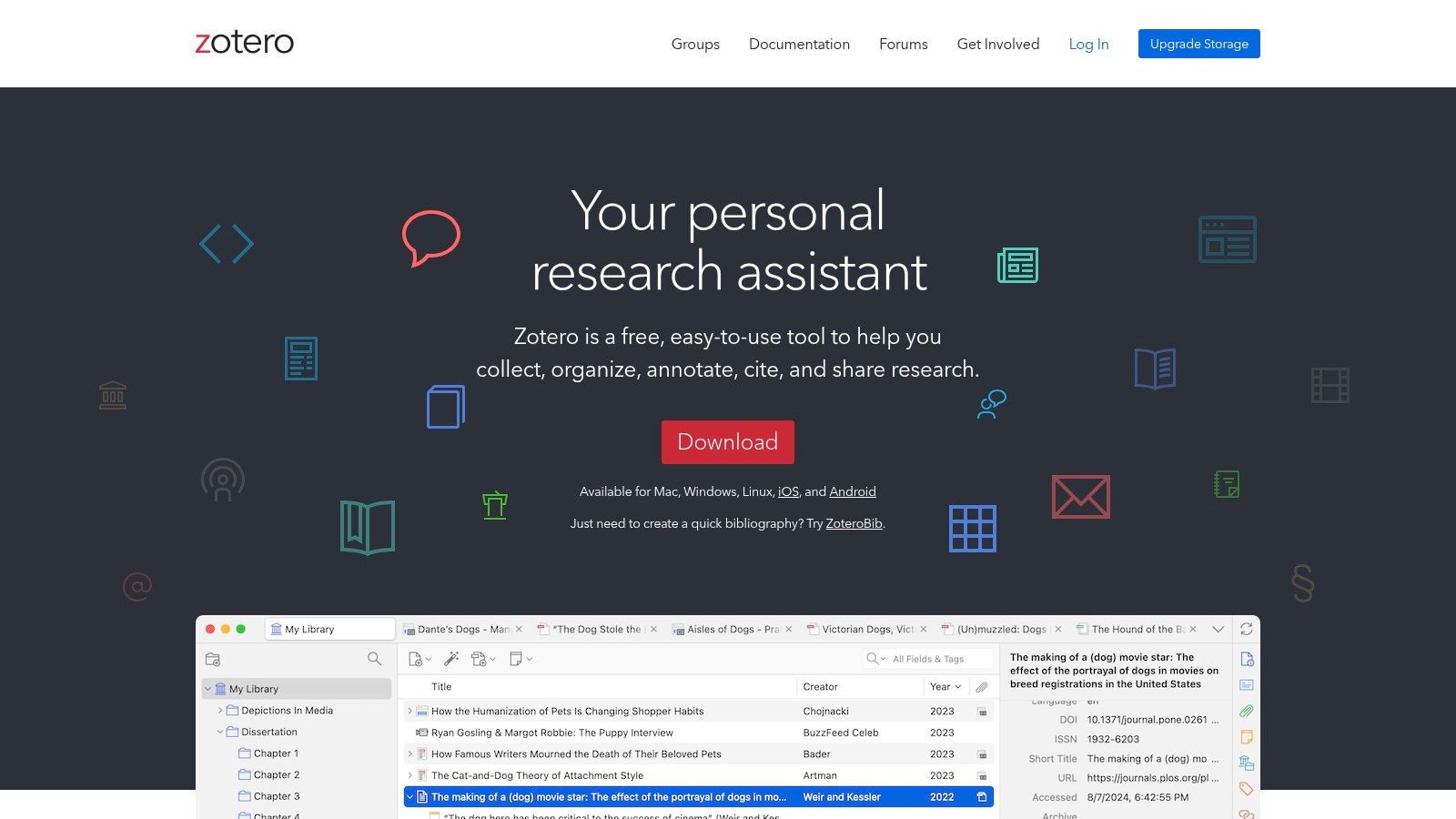
Key Considerations
- Platform: Windows, macOS, Linux, iOS, web
- Pricing: Free with 300 MB of cloud storage; paid plans for more storage
- Standout Feature: One-click source capture from web browsers and direct integration with Word and Google Docs.
- Limitation: The user interface can feel dated, and interacting with saved PDFs requires a separate reader, unlike integrated platforms that allow direct analysis of uploaded documents.
Pro Tip: Use Zotero to collect and organize your sources, then export the key research papers as PDFs and upload them to Zemith. Zemith’s Document Assistant can then help you analyze the papers, pull out key quotes, generate summaries, and even compare arguments across multiple sources, dramatically speeding up your literature review process.
Zotero's strength lies in its no-cost accessibility and powerful, research-focused feature set. While its interface may seem less modern than some commercial alternatives, its functionality is unparalleled for academic work. It's a must-have tool for any student engaged in serious research and writing, simplifying a process that is often a major source of stress. For those interested in enhancing their research process further, exploring how Zotero complements other AI-powered research tools on zemith.com can provide a significant advantage.
12. GitHub Student Developer Pack
For students in computer science, engineering, or any technical field, the GitHub Student Developer Pack is arguably the single most valuable free resource available. It bundles access to dozens of premium developer tools, services, and educational materials at no cost. This isn't just a collection of trial software; it provides legitimate, full-featured access to industry-standard tools, turning a student's laptop into a professional-grade development environment.
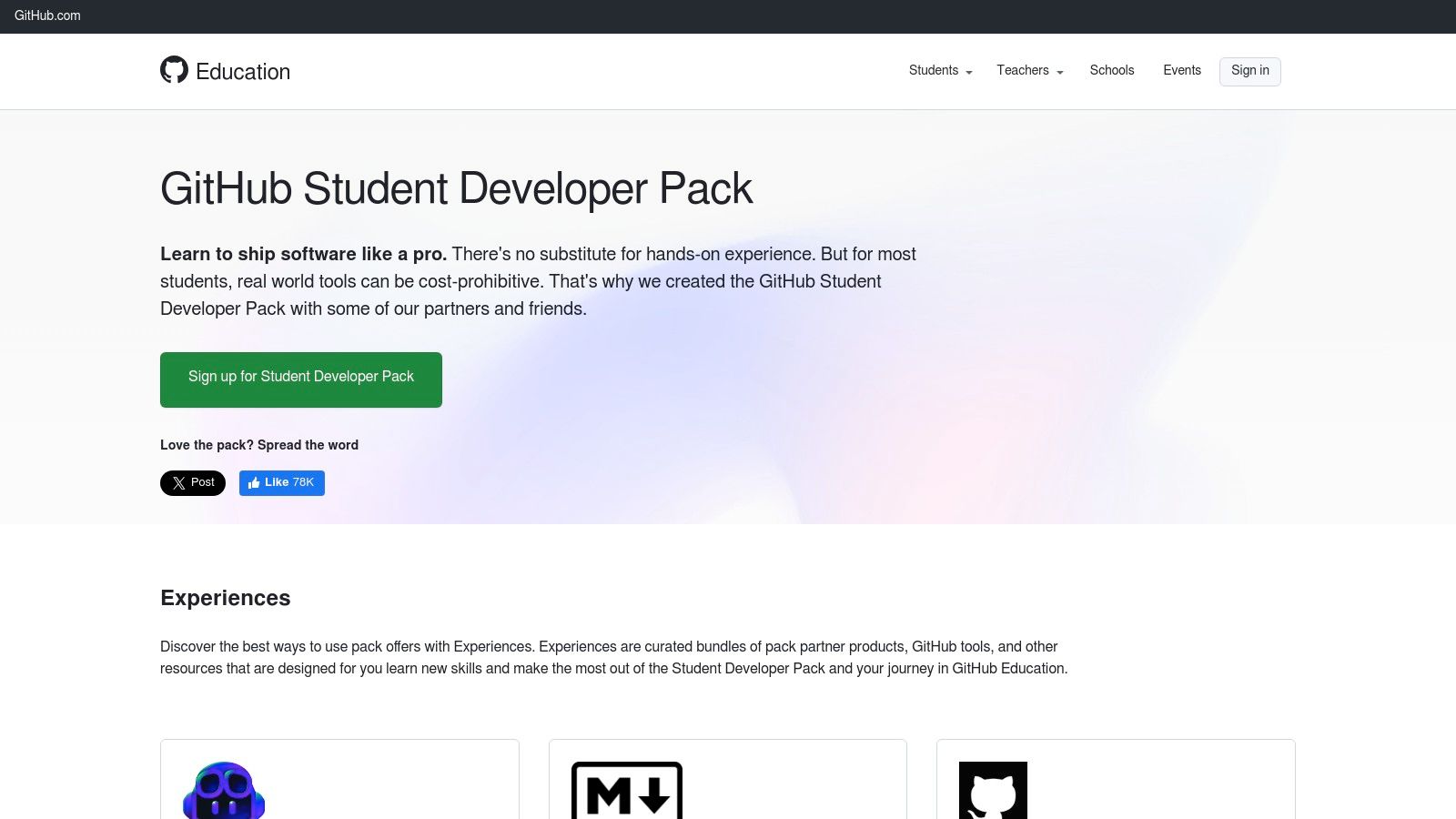
The primary value lies in its centralization and the sheer financial savings. Instead of students having to pay for cloud hosting, domain names, or advanced IDEs, GitHub provides them through its partnerships. This lowers the barrier to entry for building complex projects, experimenting with new technologies, and gaining practical skills that are directly applicable to the workforce. It’s an indispensable toolkit for any tech-focused student.
Key Considerations
- Platform: Web-based portal, with individual tools for Windows, macOS, and Linux
- Pricing: Free for all verified students
- Standout Feature: Free access to GitHub Copilot Pro, an AI pair programmer that significantly speeds up coding and learning. Many of the included tools are also some of the top AI-powered productivity tools available.
- Limitation: Heavily geared towards technical and computer science workflows; offers less direct value for non-STEM majors.
Pro Tip: Combine the power of GitHub Copilot from the pack with an integrated coding environment like Zemith. You can use Copilot for line-by-line suggestions while leveraging Zemith’s AI to explain complex code blocks, help with debugging logic, and keep your project notes and code snippets all in one organized workspace.
While its focus is narrow, the pack's value for its target audience is immense. It provides a strategic advantage, allowing students to learn with the same professional software they will encounter in their careers. The simple verification process and renewable access make it an essential resource to claim as early as possible in your academic journey.
Visit the GitHub Student Developer Pack
Top 12 Student Productivity Apps Comparison
| Platform | Core Features/Tools | User Experience / Quality ★ | Value Proposition 💰 | Target Audience 👥 | Unique Selling Points ✨ |
|---|---|---|---|---|---|
| Zemith 🏆 | Multi-model AI access, doc assistant, creative & coding tools | ★★★★★ Seamless, all-in-one | Free + from $6.99/mo, scalable | Knowledge workers, creators, devs | Integrated top AI models, live AI audio, deep research |
| Apple App Store | Curated productivity apps, device integration | ★★★★ Strong Apple ecosystem | Free to browse, paid apps | Apple device users, students | Editorial curation, Pencil & widget support |
| Google Play Store | Large app catalog, parental controls, school distribution | ★★★★ Huge selection, mixed quality | Mostly free + paid apps | Android/ChromeOS users, students | Extensive app choice, school-managed distribution |
| Microsoft Store | Productivity apps, MS365 integration, curated charts | ★★★★ Safe, integrated with Windows | Free + paid apps | Windows PC users, students | Microsoft 365 integration, awards for quality apps |
| Notion | All-in-one workspace: notes, tasks, templates, AI add-on | ★★★★ Customizable, cross-platform | Generous free + paid tiers | Students, project managers | Strong template ecosystem, Notion AI |
| Todoist | Task manager with natural language input, collaboration | ★★★★ Simple UI, reliable sync | Free + Pro subscription | Students, teams, planners | Natural date recognition, AI assistant on Pro |
| Goodnotes | Handwritten notes, PDF markup, AI assistance | ★★★★★ Best iPad Pencil support | Paid app/subscription | Students, educators, note takers | Handwriting search, audio recording |
| Forest | Pomodoro timer, gamified focus, app blocker | ★★★★ Highly rated, behavior-focused | Paid app (separate iOS & Android) | Students, focus seekers | Gamified tree growth, real tree planting |
| MyStudyLife | Academic planner: rotating schedules, reminders, Pomodoro | ★★★★ Student-specific, cross-platform | Free + premium AI features | Students | AI timetable scanning, academic-focused design |
| Grammarly | Grammar, clarity, tone checks, plagiarism detection | ★★★★★ Real-time writing feedback | Free + Premium subscription | Students, writers | Integrates with docs & email, generative AI |
| Zotero | Reference manager, citations, group libraries | ★★★★ Powerful free research tool | Free | Students, researchers | Open-source, offline use, group collaboration |
| GitHub Student Developer Pack | Verified student access to paid dev tools, credits | ★★★★★ High value, vetted offers | Free for verified students | CS/tech students | GitHub Copilot Pro, broad software vouchers |
Building Your Ultimate Student Workflow
Navigating the vast landscape of student productivity apps can feel overwhelming, but the journey from digital clutter to a streamlined academic workflow is well worth the effort. We've explored a dozen powerful tools, from comprehensive note-takers like Goodnotes and all-in-one workspaces like Notion, to specialized aids like the focus-enhancing Forest app and the indispensable Grammarly editor. Each app offers a unique solution to a specific academic challenge, whether it's managing citations with Zotero or organizing your entire semester with MyStudyLife.
The central takeaway is this: the most effective strategy isn't about downloading every app on this list. It's about strategic integration. A powerful tool used in isolation can offer marginal gains, but a thoughtfully curated system of apps working in harmony can fundamentally transform how you study, write, and manage your time. The goal is to build a personal productivity ecosystem where each component has a distinct role, minimizing friction and maximizing output.
From Individual Tools to a Cohesive System
Think of your productivity stack as a team. You wouldn't ask your star quarterback to also play as the defensive lineman. Similarly, you shouldn't force one app to do a job another is specifically designed for.
For Task Management: Todoist excels at granular, day-to-day task tracking. However, for larger, multi-stage projects like a semester-long research paper or a group presentation, you might benefit from a more visual approach. For students seeking a structured visual method to manage their tasks and projects, understanding principles like Kanban can significantly enhance their productivity. Exploring concepts like Kanban board project management can provide a framework for visualizing your workflow, from "To-Do" to "In Progress" to "Complete."
For Deep Work: Forest is brilliant for enforcing focus during dedicated study blocks. You can pair this with a tool like Goodnotes or Zotero, ensuring that once you're in the zone, all your research materials and note-taking capabilities are ready to go.
For Knowledge Synthesis: This is where the true power of a modern workflow comes alive. Your system should not just store information; it should help you connect ideas and generate new insights. The real challenge for today's student isn't access to information but making sense of it all.
The Power of an AI-Driven Hub
This is where the concept of a central "command center" becomes critical. While specialized apps handle specific tasks, a platform that can unify your efforts is the cornerstone of a truly modern student workflow. An AI-powered workspace like Zemith is designed to be this hub. It moves beyond simple organization and becomes an active partner in your learning process.
Instead of just storing your lecture notes, you can use Zemith to instantly generate flashcards, practice quizzes, or summary outlines from them. Rather than staring at a blank page for an essay, you can feed your research from Zotero into Zemith and have it help you draft an outline, suggest thesis statements, or even refine your arguments. For STEM students, the ability to get coding assistance directly within the same environment where you organize your project notes is a game-changer. This integration eliminates the constant, focus-breaking context switching that plagues many students who rely on a scattered collection of disparate tools. By consolidating these core academic tasks, you create a seamless environment where your tools amplify each other, guided by a powerful AI core.
Ultimately, the best suite of student productivity apps is the one you consistently use. Start small. Identify your single biggest academic bottleneck, whether it’s procrastination, disorganization, or writer’s block. Choose one or two tools from this list designed to solve that specific problem. As you build confidence, you can gradually integrate more apps, always asking how each new addition fits into your broader system. Build your workflow pieza por pieza, with a clear purpose for each tool, and you will construct a powerful, personalized engine for academic achievement.
Ready to stop juggling a dozen apps and build a truly integrated academic workflow? Discover how Zemith uses AI to consolidate your note-taking, writing, and research into one powerful, intelligent workspace. Try Zemith today and transform your study habits from scattered to streamlined.
Explore Zemith Features
Introducing Zemith
The best tools in one place, so you can quickly leverage the best tools for your needs.
All in One AI Platform
Go beyond AI Chat, with Search, Notes, Image Generation, and more.
Cost Savings
Access latest AI models and tools at a fraction of the cost.
Get Sh*t Done
Speed up your work with productivity, work and creative assistants.
Constant Updates
Receive constant updates with new features and improvements to enhance your experience.
Features
Selection of Leading AI Models
Access multiple advanced AI models in one place - featuring Gemini-2.5 Pro, Claude 4.5 Sonnet, GPT 5, and more to tackle any tasks
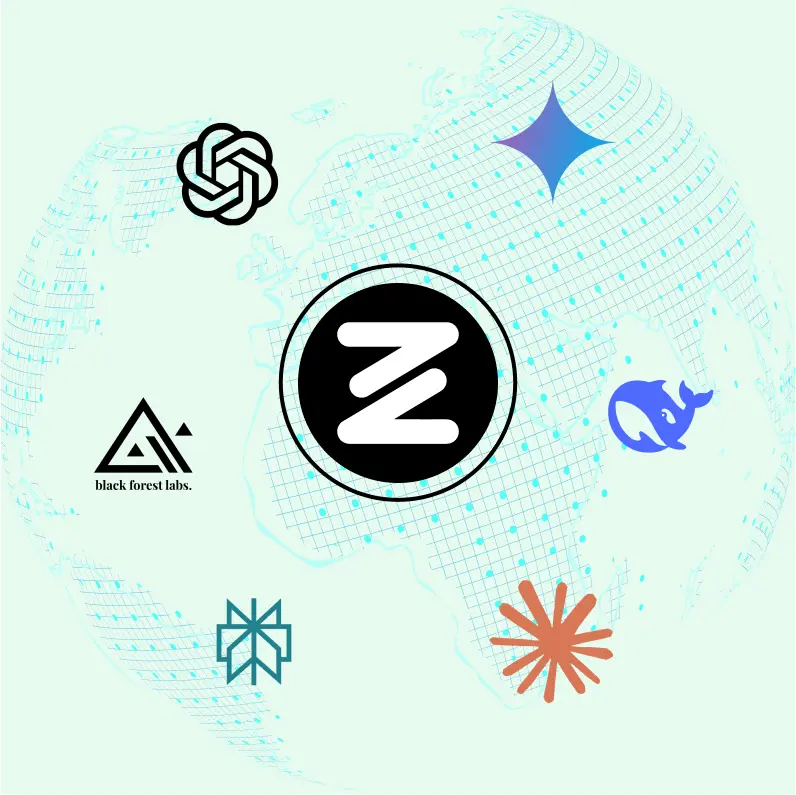
Speed run your documents
Upload documents to your Zemith library and transform them with AI-powered chat, podcast generation, summaries, and more
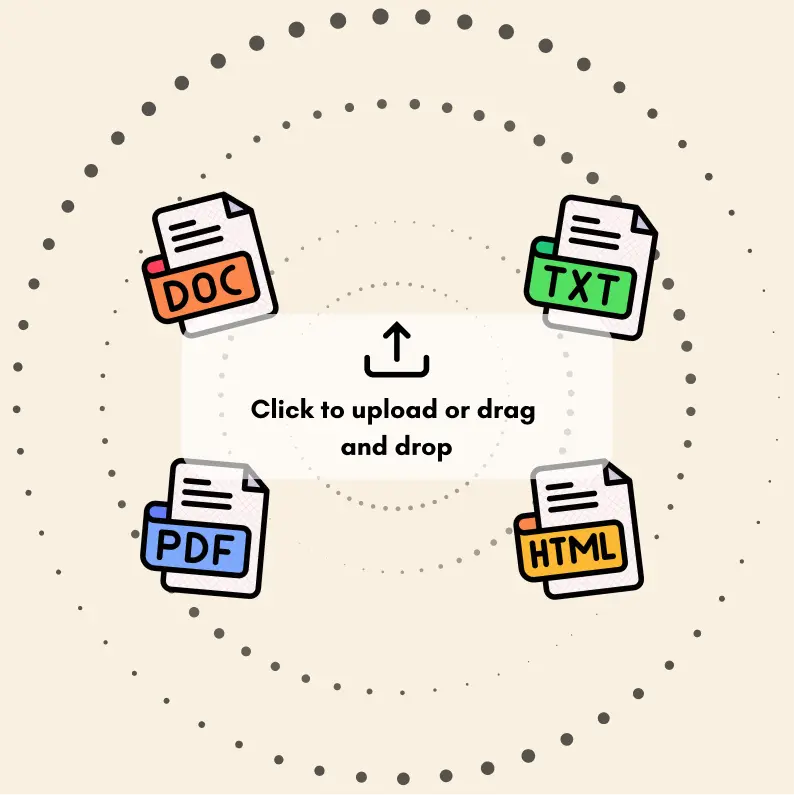
Transform Your Writing Process
Elevate your notes and documents with AI-powered assistance that helps you write faster, better, and with less effort
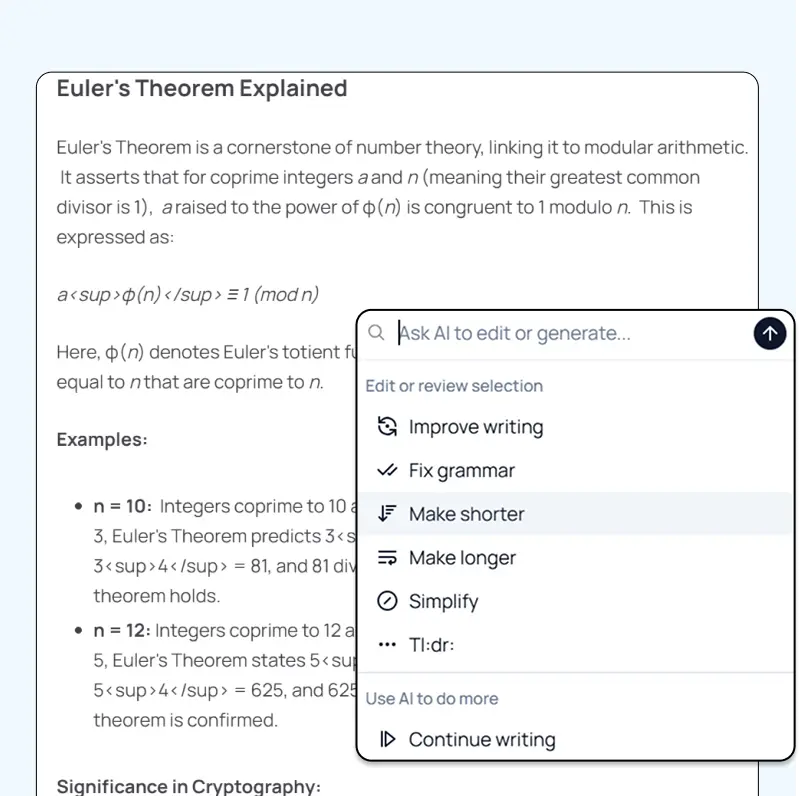
Unleash Your Visual Creativity
Transform ideas into stunning visuals with powerful AI image generation and editing tools that bring your creative vision to life
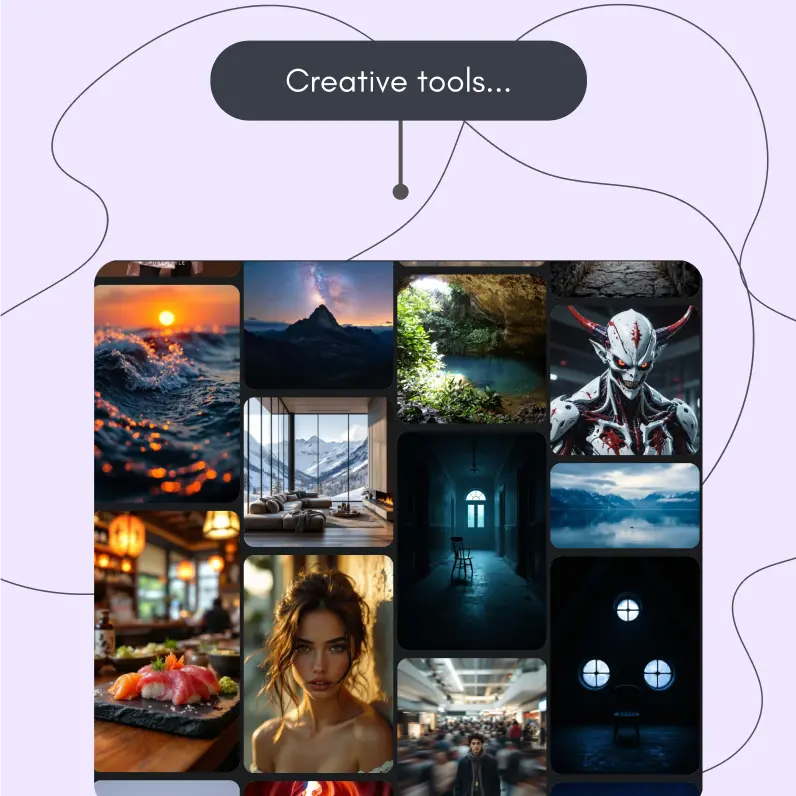
Accelerate Your Development Workflow
Boost productivity with an AI coding companion that helps you write, debug, and optimize code across multiple programming languages
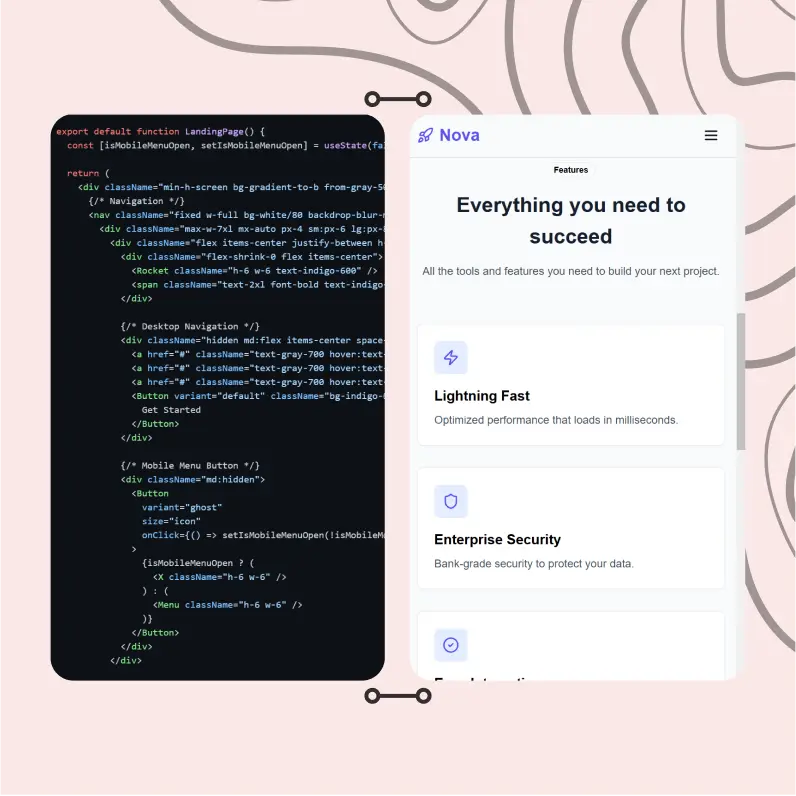
Powerful Tools for Everyday Excellence
Streamline your workflow with our collection of specialized AI tools designed to solve common challenges and boost your productivity
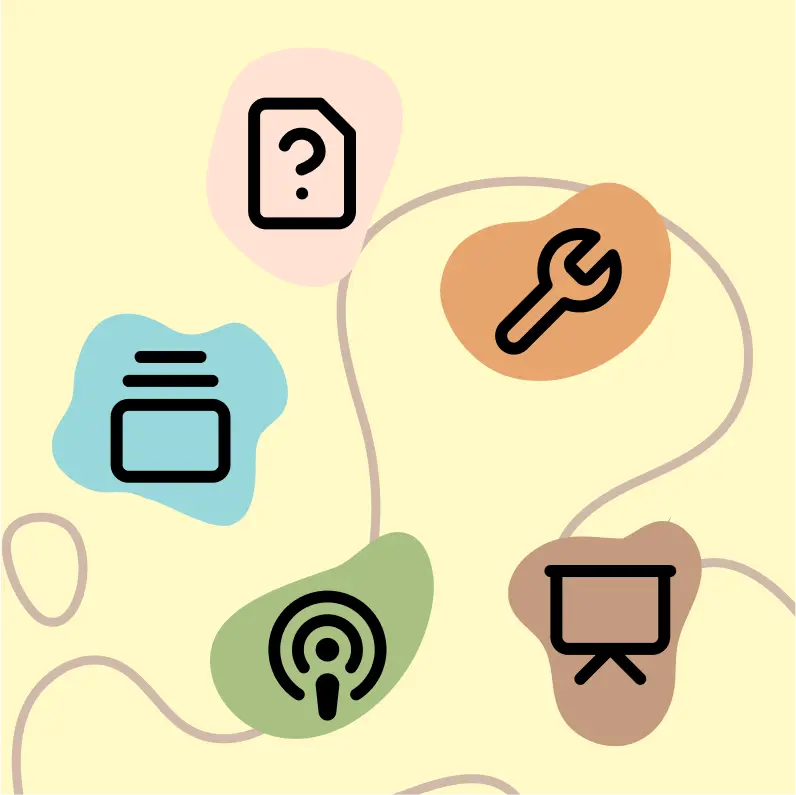
Live Mode for Real Time Conversations
Speak naturally, share your screen and chat in realtime with AI
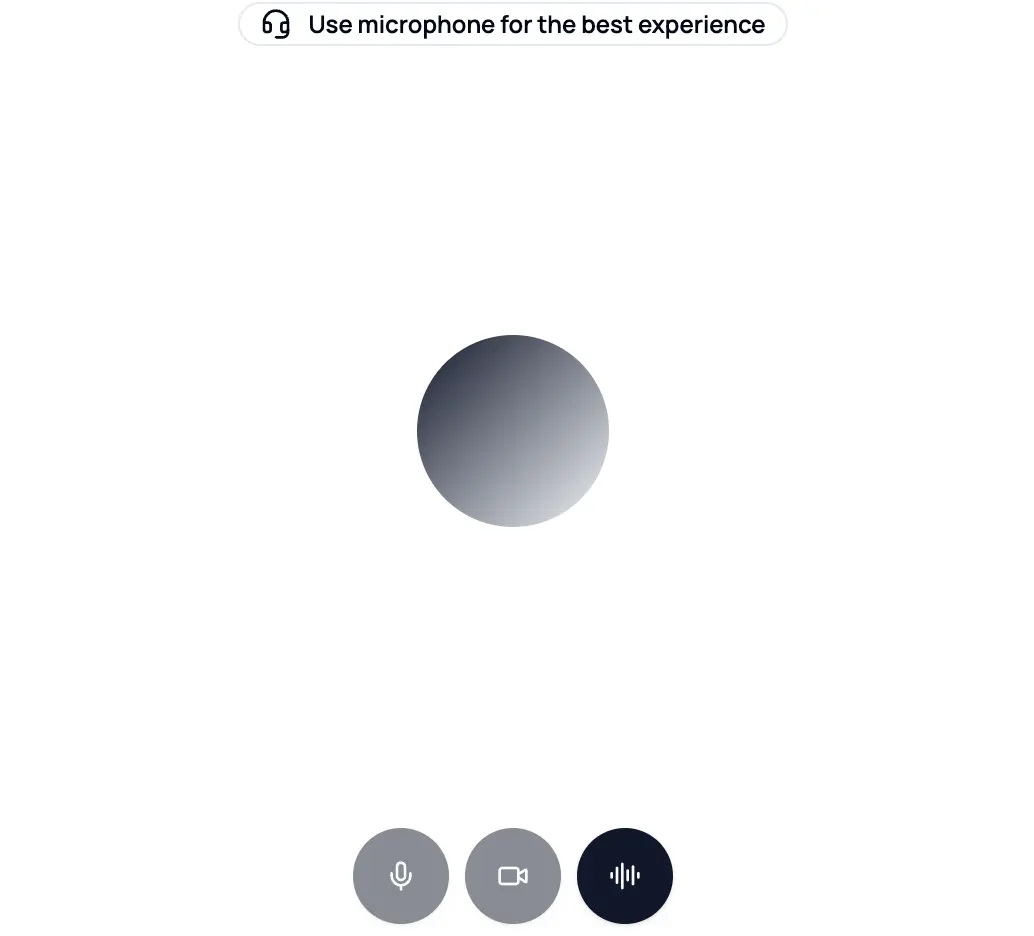
AI in your pocket
Experience the full power of Zemith AI platform wherever you go. Chat with AI, generate content, and boost your productivity from your mobile device.

Deeply Integrated with Top AI Models
Beyond basic AI chat - deeply integrated tools and productivity-focused OS for maximum efficiency
Straightforward, affordable pricing
Save hours of work and research
Affordable plan for power users
Plus
- 10000 Credits Monthly
- Access to plus features
- Access to Plus Models
- Access to tools such as web search, canvas usage, deep research tool
- Access to Creative Features
- Access to Documents Library Features
- Upload up to 50 sources per library folder
- Access to Custom System Prompt
- Access to FocusOS up to 15 tabs
- Unlimited model usage for Gemini 2.5 Flash Lite
- Set Default Model
- Access to Max Mode
- Access to Document to Podcast
- Access to Document to Quiz Generator
- Access to on demand credits
- Access to latest features
Professional
- Everything in Plus, and:
- 21000 Credits Monthly
- Access to Pro Models
- Access to Pro Features
- Access to Video Generation
- Unlimited model usage for GPT 5 Mini
- Access to code interpreter agent
- Access to auto tools
- 10000 Credits Monthly
- Access to plus features
- Access to Plus Models
- Access to tools such as web search, canvas usage, deep research tool
- Access to Creative Features
- Access to Documents Library Features
- Upload up to 50 sources per library folder
- Access to Custom System Prompt
- Access to FocusOS up to 15 tabs
- Unlimited model usage for Gemini 2.5 Flash Lite
- Set Default Model
- Access to Max Mode
- Access to Document to Podcast
- Access to Document to Quiz Generator
- Access to on demand credits
- Access to latest features
- Everything in Plus, and:
- 21000 Credits Monthly
- Access to Pro Models
- Access to Pro Features
- Access to Video Generation
- Unlimited model usage for GPT 5 Mini
- Access to code interpreter agent
- Access to auto tools
What Our Users Say
Great Tool after 2 months usage
simplyzubair
I love the way multiple tools they integrated in one platform. So far it is going in right dorection adding more tools.
Best in Kind!
barefootmedicine
This is another game-change. have used software that kind of offers similar features, but the quality of the data I'm getting back and the sheer speed of the responses is outstanding. I use this app ...
simply awesome
MarianZ
I just tried it - didnt wanna stay with it, because there is so much like that out there. But it convinced me, because: - the discord-channel is very response and fast - the number of models are quite...
A Surprisingly Comprehensive and Engaging Experience
bruno.battocletti
Zemith is not just another app; it's a surprisingly comprehensive platform that feels like a toolbox filled with unexpected delights. From the moment you launch it, you're greeted with a clean and int...
Great for Document Analysis
yerch82
Just works. Simple to use and great for working with documents and make summaries. Money well spend in my opinion.
Great AI site with lots of features and accessible llm's
sumore
what I find most useful in this site is the organization of the features. it's better that all the other site I have so far and even better than chatgpt themselves.
Excellent Tool
AlphaLeaf
Zemith claims to be an all-in-one platform, and after using it, I can confirm that it lives up to that claim. It not only has all the necessary functions, but the UI is also well-designed and very eas...
A well-rounded platform with solid LLMs, extra functionality
SlothMachine
Hey team Zemith! First off: I don't often write these reviews. I should do better, especially with tools that really put their heart and soul into their platform.
This is the best tool I've ever used. Updates are made almost daily, and the feedback process is very fast.
reu0691
This is the best AI tool I've used so far. Updates are made almost daily, and the feedback process is incredibly fast. Just looking at the changelogs, you can see how consistently the developers have ...
